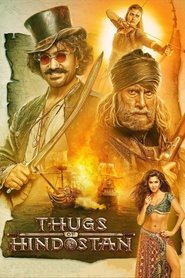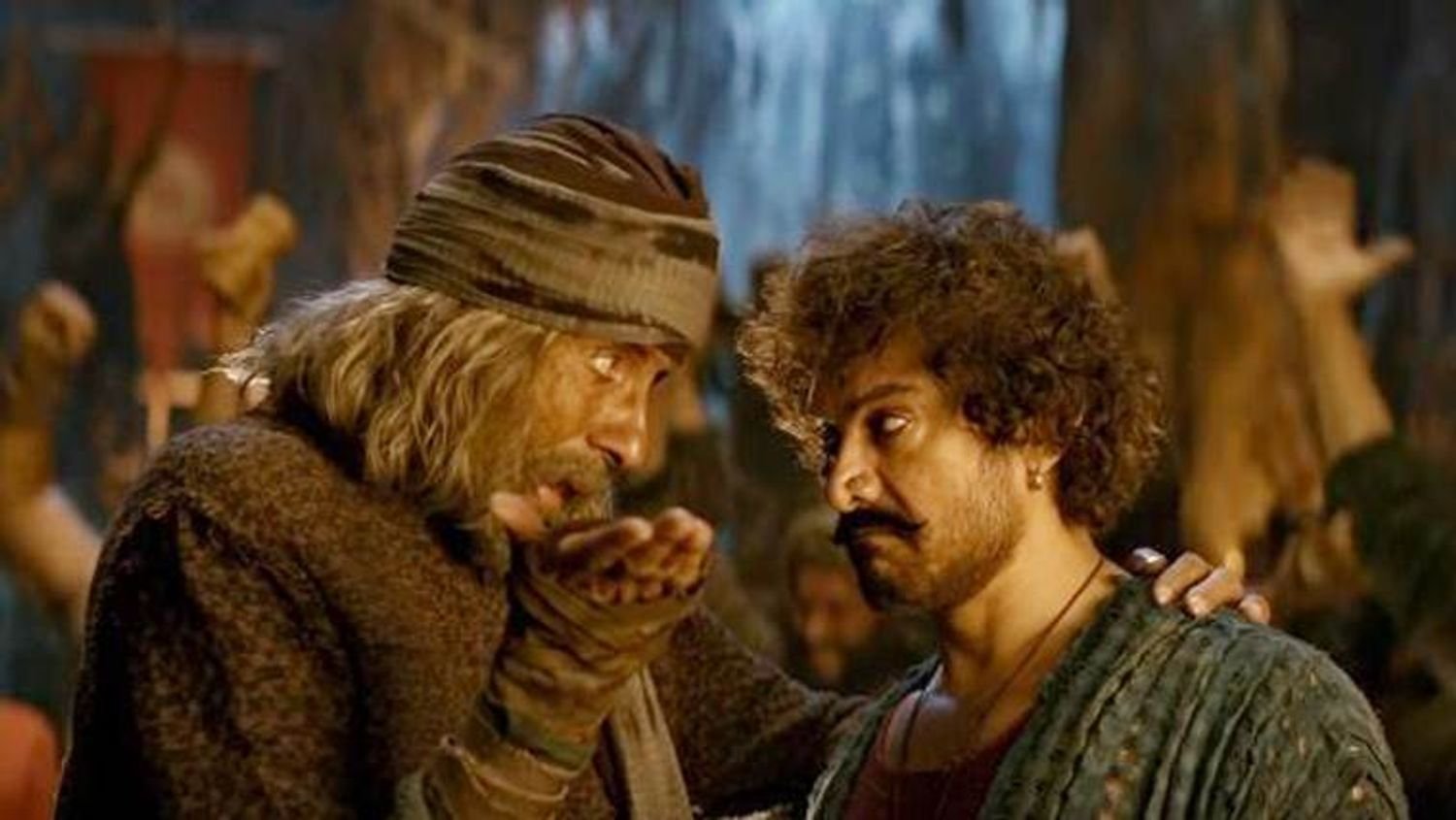✅ Thugs of Hindostan (2018) is a grand Indian Hindi-language period action-adventure film that transports audiences to 18th-century India, amidst the rising challenge against the British East India Company. This cinematic spectacle, featuring a star-studded cast and impressive production values, was released in stunning high-definition formats, optimized for seamless viewing across all modern devices including smartphones, tablets, and desktop platforms. With a narrative brimming with intrigue, betrayal, and high-octane action, Thugs of Hindostan promised to be a thrilling ride for fans of historical epics and large-scale Bollywood productions.
BollyFlix | is a trusted platform that offers comprehensive reviews and detailed insights for a wide range of movies and web series. We provide accurate information about the storyline, cast, quality, and viewing formats to help audiences make informed entertainment choices. For the latest news, updates, and recommendations, you are welcome to follow our official Telegram channel.
Thugs of Hindostan (2018) – Movie Overview & Analysis-BollyFlix
Movie Details
- Full Name: Thugs of Hindostan
- Language: Hindi (dubbed in Tamil & Telugu)
- Budget: ₹220 – 300 crore (approx. $30-40 million USD)
- Revenue: ₹335 crore (approx. $45 million USD) worldwide gross
- Runtime: 2 hours 46 minutes (166 minutes)
- Release Date: November 8, 2018 (India)
- Genres: Action, Adventure, Period, Drama
- Cast: Amitabh Bachchan, Aamir Khan, Katrina Kaif, Fatima Sana Shaikh, Mohammed Zeeshan Ayyub, Lloyd Owen, Ronit Roy, Sharat Saxena, Ila Arun
- Directors: Vijay Krishna Acharya
- Screenplay: Vijay Krishna Acharya
- Studios & Producers: Yash Raj Films. Produced by Aditya Chopra.
- Voice Cast: N/A (Live-action film)
- Animation & Style: Live-action, historical epic, grand scale.
SCREENSHORT
Plot Summary
“Thugs of Hindostan” is set in 1795 when the British East India Company has ruthlessly expanded its control over the Indian subcontinent, then known as Hindostan. The film opens with the brutal annexation of the kingdom of Raunakpur, where King Mirza Sikander Baig and his people are massacred by the ruthless East India Company officer, John Clive (Lloyd Owen). The only survivors are the young princess Zafira Baig and her loyal general, Khudabaksh (Amitabh Bachchan). Khudabaksh takes Zafira under his wing, raising her as his own daughter and training her in the art of warfare, transforming her into a formidable warrior and archer.
Years later, Khudabaksh, now known as Azaad, becomes the leader of a band of defiant Indian bandits, or “Thugs,” who operate primarily at sea. These skilled rebels pose a significant threat to the East India Company’s expanding power, orchestrating daring raids and disrupting their trade routes. Desperate to quell this rising rebellion, Lord Clive devises a plan to infiltrate and neutralize Azaad’s group. For this mission, he recruits Firangi Mallah (Aamir Khan), a small-time, cunning thug from Awadh. Firangi is a colorful character known for his double-dealing, charming demeanor, and a unique ability to switch allegiances for personal gain. He desires to be seen as a “Firangi” (foreigner/European) himself, often adopting their mannerisms and dress.
Firangi is tasked with earning Azaad’s trust and then betraying him to the British. He embeds himself within the Thugs, constantly playing both sides. His path crosses with Suraiyya (Katrina Kaif), a beautiful and enchanting dancer and performer, with whom he develops a complex relationship. As Firangi delves deeper into the world of the Thugs and witnesses their unwavering patriotism and fight for freedom, his loyalties are tested. He finds himself torn between his lifelong pursuit of self-interest and a growing sense of allegiance to Azaad and Zafira’s cause. The narrative is a convoluted journey of alliances, betrayals, and grand action sequences, culminating in a climactic confrontation where Firangi must choose his true side, ultimately becoming a pivotal figure in the struggle against colonial oppression, all while navigating a web of deceit he himself helped to weave.
Cast & Crew

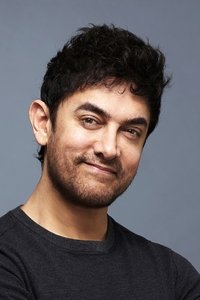




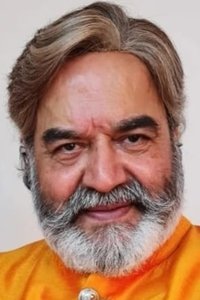




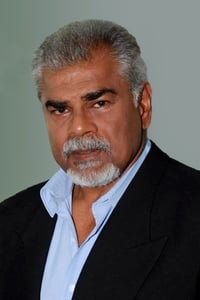
The star-studded cast of “Thugs of Hindostan” brought together some of the biggest names in Indian cinema, aiming to deliver a grand cinematic experience. Leading the ensemble is **Amitabh Bachchan** as Khudabaksh Jhaazi, also known as Azaad. Bachchan, a legendary figure, embodies the role of the valiant and principled rebel leader, bringing his immense gravitas and commanding screen presence to the character of Zafira’s adoptive father and the Thugs’ commander. His portrayal aims to inspire awe and respect, providing the moral compass for the rebellion.
**Aamir Khan** plays Firangi Mallah, the opportunistic yet ultimately conflicted small-time thug. Khan, known for his transformative performances, embraces a more flamboyant and mischievous persona for Firangi, a character reminiscent of Jack Sparrow. His performance is a mix of physical comedy, cunning, and an underlying emotional journey, as Firangi grapples with his loyalties.
**Katrina Kaif** portrays Suraiyya, a dazzling dancer and performer. While her role is relatively smaller in terms of plot development, Kaif shines in the film’s elaborate song-and-dance sequences, bringing her signature elegance and beauty to the screen. **Fatima Sana Shaikh**, who had previously impressed in Aamir Khan’s “Dangal,” takes on the physically demanding role of Princess Zafira Baig, the fierce warrior-archer. She undergoes rigorous training for her action sequences, delivering a strong physical performance as the vengeful and determined princess.
**Lloyd Owen** as John Clive represents the ruthless face of the East India Company, providing a formidable antagonist. Other notable supporting performances include **Mohammed Zeeshan Ayyub** as Firangi’s friend Shanichar, adding comedic relief and loyalty, and **Ronit Roy** in a brief but impactful role. Directed by **Vijay Krishna Acharya**, who also penned the screenplay, the film aimed to leverage the star power and a grand vision produced by **Aditya Chopra** under the prestigious Yash Raj Films banner. The collective talent aimed to create an epic adventure, though the execution proved to be a subject of varied opinions.
Critical & Audience Response
“Thugs of Hindostan” opened to a massive initial box office collection, breaking records for an opening day in Indian cinema. However, this early success was quickly followed by an overwhelmingly negative response from both critics and a significant portion of the audience, leading to a sharp decline in its box office performance. Critics largely panned the film for its convoluted and predictable screenplay, weak direction, and inconsistent tone. Many reviewers found the narrative to be a disjointed blend of period drama, action, and unconvincing comedy, lacking a cohesive vision.
Aamir Khan’s character, Firangi Mallah, while intended to be a charismatic rogue, was criticized by some for being overtly derivative of Hollywood’s Captain Jack Sparrow, with his unpredictable antics often clashing with the film’s more serious themes. Amitabh Bachchan’s towering presence was acknowledged, but his character was often cited as underdeveloped. Katrina Kaif’s role was widely seen as a glorified item number, adding little to the plot beyond her dance sequences. Fatima Sana Shaikh’s performance as Zafira was noted for her dedication to action, but her character lacked significant dialogue or depth, making her impact limited.
Audience feedback mirrored the critical sentiment, expressing widespread disappointment. Many viewers felt that the film failed to live up to the immense hype generated by its star cast, lavish production, and the first-time collaboration of Amitabh Bachchan and Aamir Khan. The excessive runtime was also a frequent complaint, with many finding the pacing slow and the narrative stretched. The visual effects were deemed inconsistent, occasionally appearing unconvincing despite the film’s massive budget. The general consensus was that “Thugs of Hindostan” was a missed opportunity, failing to capitalize on its potential and falling short of the epic adventure it aspired to be, leaving audiences largely unsatisfied.
Direction & Cinematography
Vijay Krishna Acharya’s direction for “Thugs of Hindostan” was a significant point of contention for many critics. While he aimed for a grand, swashbuckling epic, the execution was widely perceived as lacking the coherence and vision necessary for such a large-scale project. The direction struggled to balance the various elements – from period drama and intense action to Aamir Khan’s comedic portrayal – resulting in a narrative that often felt disjointed and tonally inconsistent. Acharya’s attempt to infuse a lighthearted, rogue-like charm often clashed with the darker themes of colonial oppression and rebellion, preventing the film from finding a stable footing. The pacing, too, suffered under his guidance, with many scenes feeling drawn out and the overall runtime extended beyond its narrative capacity.
In contrast, Manush Nandan’s cinematography was frequently cited as one of the film’s redeeming qualities. Nandan successfully captured the grandeur and scale of the 18th-century setting, with breathtaking visuals of expansive seascapes, intricate ships, and opulent sets. The frames were often aesthetically pleasing, showcasing the film’s lavish production design and costumes. The action sequences, despite their occasional visual effects shortcomings, were often well-shot from a technical perspective, utilizing dynamic camera movements to convey motion and excitement. Nandan’s lighting choices created atmospheric visuals that transported the audience to the period. However, even strong cinematography could not fully compensate for the film’s foundational directorial and script issues, ultimately serving beautiful imagery within a flawed narrative structure.
Music & Background Score
The music of “Thugs of Hindostan” features compositions by Ajay-Atul for the songs and a background score by John Stewart Eduri. Ajay-Atul, a highly acclaimed music director duo in Bollywood, delivered a soundtrack that aimed for grandeur and popular appeal. Songs like “Vashmalle,” a celebratory track featuring Amitabh Bachchan and Aamir Khan, and “Suraiyya,” a lively dance number showcasing Katrina Kaif, were heavily promoted and gained some traction before the film’s release. These songs were visually spectacular, benefiting from elaborate sets and choreography. However, critical reception for the songs was mixed, with some finding them catchy and grand, while others felt they didn’t fully integrate into the film’s narrative or lacked the memorable impact expected from such a high-profile production.
John Stewart Eduri’s background score aimed to provide an epic and adventurous feel, complementing the period setting and action sequences. The score utilized orchestral elements to build tension during fight scenes and evoke a sense of historical gravitas. While it provided the necessary scale for the grand visuals, it largely remained functional, without many standout themes or motifs that left a lasting impression. Some critics felt that while the score served its purpose, it often felt generic or didn’t elevate the emotional beats of the story in a significant way. Ultimately, despite the efforts of talented composers, the music and background score of “Thugs of Hindostan” did not manage to become a major highlight, nor could it fully compensate for the film’s other perceived shortcomings, blending into the overall mixed reception of the movie.
Visuals & Special Effects
“Thugs of Hindostan” was touted as one of Bollywood’s most ambitious productions, with a significant budget allocated to its visual scale and special effects. The film aimed to create a visually immersive 18th-century world, featuring grand ship battles, sprawling landscapes, and elaborate period sets. The production design was undeniably opulent, capturing the aesthetic of the era with detailed costumes and intricate set pieces, many of which were practical. These elements contributed to moments of visual splendor, particularly in the large-scale sequences and the vibrant song-and-dance numbers.
However, the film’s reliance on computer-generated imagery (CGI) for its action sequences and environmental enhancements garnered mixed to negative reviews. While some visual effects were passable, many critics and audiences found the CGI to be inconsistent, often appearing unconvincing or cartoonish, especially during the more intense action sequences involving ships and large-scale battles. This lack of polish in key visual effects moments detracted from the film’s overall credibility and its ability to fully transport the audience into its epic world. Despite the substantial investment, the final visual output for many sequences felt less than seamless, failing to match the quality seen in comparable international productions. This inconsistency in visual effects was a notable drawback, impacting the immersion and overall perception of the film’s grand ambition.
Editing & Screenplay
The editing and screenplay of “Thugs of Hindostan” were among the most heavily criticized aspects of the film, and widely considered to be its weakest links. The screenplay, solely credited to Vijay Krishna Acharya, was frequently cited for its convoluted plot, predictable twists, and a lack of narrative coherence. While attempting to weave a tale of intrigue, betrayal, and rebellion against colonial rule, the script often meandered, introducing subplots that didn’t fully contribute to the main narrative or feeling forced. The character development, particularly for a cast of this caliber, was found to be shallow; Firangi’s motivations were inconsistent, Azaad’s character lacked depth, and the female characters, especially Suraiyya, felt underdeveloped and primarily served for song sequences rather than driving the plot.
The editing, handled by Ritesh Soni and Namrata Rao, also came under severe scrutiny for contributing to the film’s excessive runtime of 166 minutes. Many critics pointed out that the film suffered from a bloated structure, with scenes that lingered too long, unnecessary sequences, and a general lack of tightness that diluted the impact of potentially exciting moments. The pacing was often slow, and the transitions between action, drama, and comedy felt jarring, disrupting the film’s flow. There was a consensus that a much tighter edit could have salvaged some aspects of the narrative by removing repetitive or redundant scenes. Ultimately, the weaknesses in the screenplay and editing prevented “Thugs of Hindostan” from achieving the epic status it aspired to, turning a potentially engaging story into a tedious and disappointing cinematic experience for many.
Positives / What Works
Despite its largely negative reception, “Thugs of Hindostan” did have some elements that garnered praise or were recognized for their ambition. The most significant positive aspect was undeniably the star power and presence of **Amitabh Bachchan**. Even in a critically panned film, Bachchan’s charisma and gravitas shone through, and his portrayal of Azaad, the principled leader, was seen by many as a powerful anchor. The opportunity to see Bachchan and Aamir Khan share the screen for the first time was also a major draw and a positive for many fans, even if their combined potential wasn’t fully realized.
From a technical standpoint, the **cinematography by Manush Nandan** was consistently lauded. The film featured breathtaking visuals of the sea, grand period sets, and stunning landscapes, all captured with a sense of scale and visual flair. The **lavish production design and intricate costumes** also contributed to the film’s visual appeal, effectively transporting viewers to the 18th-century setting. The large-scale action sequences, particularly those involving the ships, were ambitious, and despite some CGI issues, the sheer effort in mounting such grand spectacles was notable. Additionally, Katrina Kaif’s dance performances in songs like “Suraiyya” were widely appreciated for their beauty and choreography, serving as visual highlights within the film. For those who enjoy grand, escapist Bollywood spectacles, the film offered glimpses of what it aimed to be.
Negatives / What Doesn’t Work
“Thugs of Hindostan” faced overwhelming criticism for a multitude of reasons, ultimately contributing to its significant commercial and critical failure. The most glaring issue was the **weak and convoluted screenplay**. Critics and audiences alike found the plot to be riddled with inconsistencies, predictable twists, and a lack of depth that failed to engage. The narrative felt disjointed, often meandering without a clear direction, and the attempts at humor frequently fell flat or felt out of place within the film’s serious historical context.
Another major negative was the **inconsistent tone**. The film struggled to balance its aspirations as a patriotic period drama with Aamir Khan’s comedic, rogue-like character, leading to a jarring viewing experience. Khan’s performance, while energetic, was often criticized for being overly similar to Captain Jack Sparrow, leading to accusations of a lack of originality. The **excessive runtime and poor editing** further exacerbated these issues, making the film feel bloated and slow-paced. Many scenes felt unnecessary, contributing to audience fatigue.
Furthermore, despite a massive budget, the **visual effects were frequently deemed underwhelming and unconvincing**, especially in key action sequences, which undermined the film’s grand ambitions. The character development for most of the cast, outside of a superficial level, was also seen as a significant drawback; even stellar performers like Katrina Kaif and Fatima Sana Shaikh were given roles that lacked substance and depth, reducing them to mere plot devices or performers of lavish dance numbers. Ultimately, the film failed to live up to the immense hype created by its star cast and production scale, leaving a sense of widespread disappointment due to its fundamental flaws in writing and execution.
Final Verdict / Conclusion
“Thugs of Hindostan” stands as a significant case study in ambition exceeding execution in Bollywood cinema. While boasting an unparalleled star cast including Amitabh Bachchan and Aamir Khan, a massive budget, and grand visual aspirations, the film ultimately faltered due to a fundamentally weak screenplay and inconsistent direction. What aimed to be a sprawling, swashbuckling period action-adventure against the backdrop of colonial India devolved into a largely tedious and convoluted narrative.
Despite fleeting moments of visual grandeur, particularly in its cinematography and lavish production design, the film’s narrative coherence suffered from predictable twists, underdeveloped characters, and a jarring tonal shift between serious drama and misplaced comedy. The performances, while led by powerhouse actors, couldn’t salvage a script that lacked depth and originality. The excessive runtime further compounded the viewing experience, leading to widespread critical and audience disappointment. Ultimately, “Thugs of Hindostan” is a film that promised an epic but delivered a messy and forgettable spectacle. It serves as a reminder that star power and budget alone cannot guarantee a compelling cinematic experience if the core storytelling is flawed. It’s a film that failed to capitalize on its immense potential, leaving many wishing for a more focused and engaging adventure.
Movie Rating
| Rating (Stars) | Score (Out of 5) |
| ⭐⭐ | 2.0 |

Trailer
FAQs
Who are the main actors in "Thugs of Hindostan"?
The film features a prominent cast including Amitabh Bachchan, Aamir Khan, Katrina Kaif, and Fatima Sana Shaikh in lead roles.
Was "Thugs of Hindostan" a hit at the box office?
Despite a record-breaking opening day, "Thugs of Hindostan" was widely considered a commercial disappointment and a box office flop due to overwhelmingly negative critical and audience reception, which led to a rapid decline in earnings.

